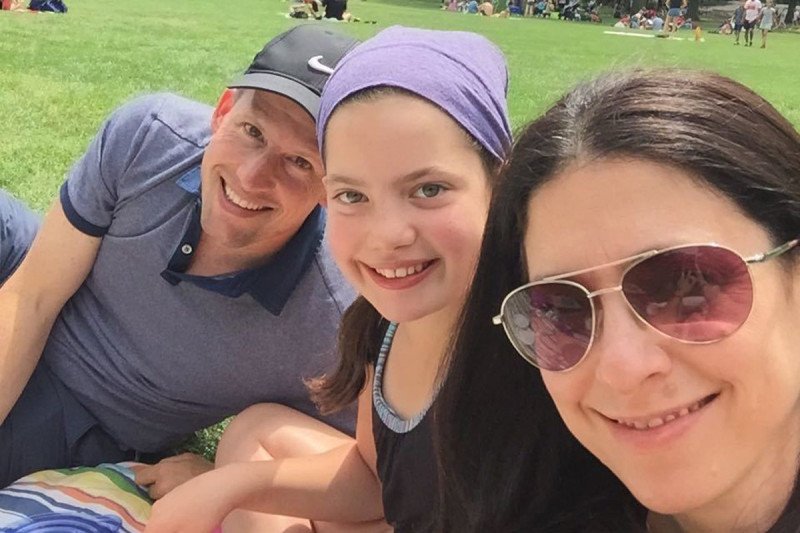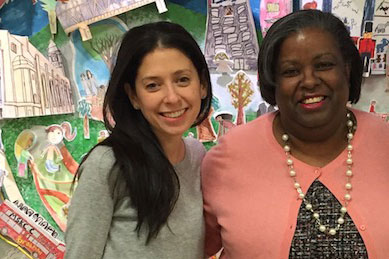
In the late 1980s, when she was 13, Amy Blumenfeld was diagnosed with Hodgkin lymphoma. She had 11 months of chemotherapy at a hospital near her home in Queens, New York. But when symptoms of her illness returned shortly after she finished that initial treatment, her parents took her to MSK.
There, doctors told Ms. Blumenfeld and her family that they could try more chemotherapy, which was unlikely to work, or a new experimental procedure called an autologous bone marrow transplant. It would replace Ms. Blumenfeld’s diseased cells with her own healthy bone marrow. Neither option was risk free or came without side effects, and an autologous bone marrow transplant had never been performed on a teenager with Hodgkin lymphoma at MSK before.
“My parents went across the street to the diner, and over a cup of tea had to make this decision,” Ms. Blumenfeld recalls. “They came back and said, ’OK, let’s go for the transplant.’
A Surgery to Save Her Life — and Her Fertility
Ms. Blumenfeld would first have a week of high-dose radiation followed by a week of high-dose chemotherapy to deplete her immune system. Then she would get the transplant.
But first, she needed surgery to harvest her healthy bone marrow. That took place in February 1989. During the procedure, MSK doctors shifted Ms. Blumenfeld’s ovaries out of the way so they wouldn’t be affected by the radiation she later needed. This way, if she wanted to have biological children one day, she could.
“It’s incredible that the doctors here had the foresight to do that,” she says.
Three months after the surgery, Ms. Blumenfeld had a successful transplant performed by Richard O’Reilly, then Chair of the Department of Pediatrics. Dr. O’Reilly is a world-renowned expert in transplantation, having performed the first-ever transplant from an unrelated donor to a patient in 1973. While Ms. Blumenfeld recovered in a reverse isolation room to keep her immune system safe as it recovered, she took her high school regents exams — and got some help from caring MSK staffers.
“Fellows, residents, and nurses tutored me in math and biology,” Ms. Blumenfeld recalls. “I got a 100 on math and a 92 on biology and they posted my scores in the nurses’ station.”
She also relied on the kindness of strangers quite literally: She recalls a woman who continued to donate blood to her, even after her own loved one, who was also a pediatric patient, passed away.
Ms. Blumenfeld would have to remain in the hospital until July. To cheer her up while she recovered, a group of family friends from her synagogue filmed a series of Saturday Night Live–style skits for her.
“It kept me laughing, and that became one of the sources of inspiration for the novel that I wrote,” she says.
A Story Comes to Life
Ms. Blumenfeld went on to pursue a master’s degree at Columbia University’s Graduate School of Journalism in 1997. She didn’t have to look far for inspiration for her final project — it came out of a conversation she had in the waiting room at one of her yearly survivorship checkups at MSK.
“The woman sitting to my right was nervous, and her daughter was on the other side of her,” Ms. Blumenfeld explains. “She said, ‘Are you waiting for somebody?’ I said no, that I was a patient, and pulled up my sleeve to show her my ID tag. She was blown away — not by me but by what it represented: a hope and a future for her daughter.”
Ms. Blumenfeld knew she had a unique perspective to share with this family. She started thinking about what happens when a child with cancer walks out of the hospital doors, and how people move on. She wanted to know: What are the ripple effects of going through cancer at a young age?

It had been nearly a decade since Ms. Blumenfeld finished treatment, but the experience remained fresh in her mind. She wanted to revisit it — and everything that came after — on the page.
Ms. Blumenfeld’s professor at Columbia was impressed with the story.
“He said, ‘You should think about turning this into something larger,’ ” she recalls. “That planted a seed.” She began writing more material, but also devoted time to building a family. She got married and welcomed a daughter, Mia, who is now 12.
Reflecting on Cancer and Adulthood
When Ms. Blumenfeld turned 40, she thought more broadly about her own life and the lives of her friends. She thought about the physical and emotional challenges she faced after cancer treatment, as well as other challenges her friends faced as they waded through adulthood. She had an idea.
“I thought, Why don’t I take some of these issues and create characters who are like my friends, and then infuse those important messages from my master’s project?” she recalls.
Ms. Blumenfeld began weaving a story that delved into topics other than cancer, such as marriage and friendship. But she included personal details as well: The videotape from her friends, for example, serves as a jumping-off point for her plot. In August 2018, The Cast hit shelves.
Thriving after Pediatric Cancer
Every year, Ms. Blumenfeld visits MSK for a survivorship checkup with pediatric hematologic oncologist Tanya Trippett. Ms. Blumenfeld credits MSK not only with saving her life but also with keeping her healthy over the years.
“This hospital has been incredible,” she says. “They saved my life numerous times. As a survivor, you need to be vigilant about your long-term care. I trust Dr. Trippett. With her in the driver’s seat, I’m a happy passenger buckled in the back.”



